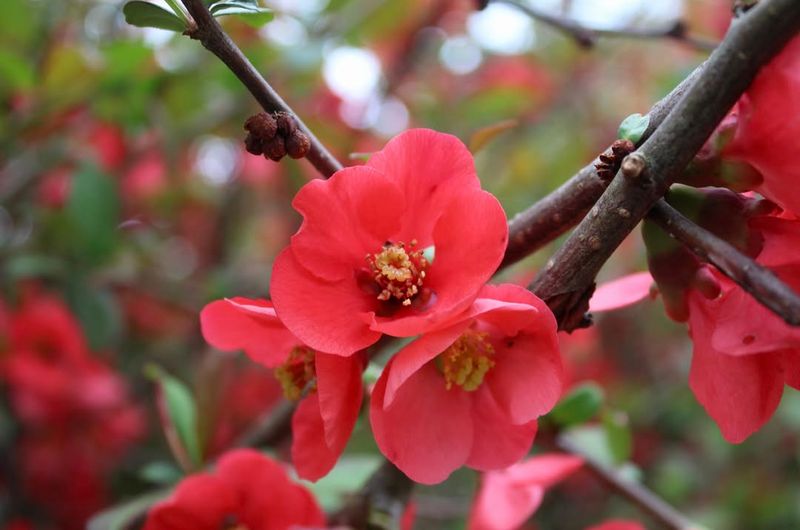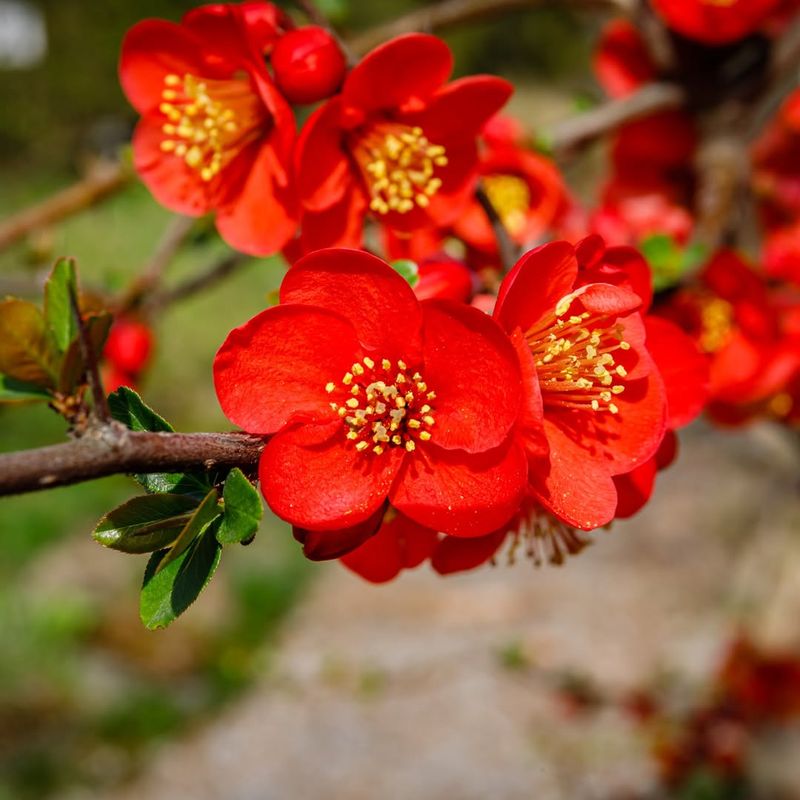Flowering quince is one of those shrubs that makes Virginia gardens come alive when winter finally loosens its grip. Its fiery red blossoms appear in early spring, often while frost still lingers on the ground, bringing a burst of color when you need it most.
This tough, low-maintenance plant thrives in our state’s climate and offers far more than just pretty flowers.
1. Blooms Arrive When Other Plants Are Still Sleeping
While most of your garden is still recovering from winter, flowering quince bursts into bloom as early as late February or March. The brilliant red flowers appear before the leaves, creating a stunning display against bare branches.
Virginia gardeners appreciate this early show because it signals warmer days ahead. Pollinators like bees emerge from dormancy and find these blooms waiting, making your yard an important food source. The timing couldn’t be better for both beauty and ecological support in our state’s unpredictable spring weather.
2. Handles Virginia’s Temperature Swings With Ease
Our state experiences everything from humid summers to occasional harsh winter freezes, and flowering quince handles it all without complaint. This shrub is hardy in zones 4-8, which covers all of Virginia perfectly. Once established, it doesn’t need babying through temperature changes.
The plant’s natural resilience means you won’t lose sleep worrying about sudden cold snaps damaging your investment. Many gardeners in Richmond, Roanoke, and beyond have enjoyed decades of blooms from the same shrub, proving its staying power in our variable climate.
3. Deer Usually Leave It Alone
If you’ve gardened in Virginia for any length of time, you know deer can be a serious problem. They’ll munch through hostas, roses, and tulips like they’re at an all-you-can-eat buffet. Flowering quince, however, doesn’t typically make their menu.
The thorny branches and less palatable foliage discourage browsing, so your spring blooms stay intact. This makes it an excellent choice for properties near wooded areas or anywhere whitetails wander regularly, giving you one less headache during growing season.
4. Creates A Natural Privacy Screen With Character
Flowering quince grows into a dense, rounded shrub that typically reaches 6-10 feet tall and wide, making it perfect for creating privacy without installing a fence. The tangled branching pattern fills in nicely, blocking views year-round. During spring, the red blooms transform your privacy screen into a showpiece.
Virginia homeowners often plant several in a row along property lines, creating living boundaries that look intentional and beautiful. The thorny branches also discourage unwanted foot traffic, adding a practical security element to your landscaping.
5. Requires Minimal Care Once Settled In
After the first year or two, flowering quince becomes remarkably self-sufficient. It tolerates a range of soil types common throughout Virginia, from clay to sandy loam, and doesn’t demand constant fertilizing or special amendments.
Watering needs drop significantly once roots establish, and the plant handles our summer heat without wilting. Pruning is optional—mainly for shape control—and pest problems are rare. For busy gardeners who want beauty without endless weekend chores, this shrub delivers dependable results with surprisingly little effort invested.
6. Produces Edible Fruit For Homemade Preserves
After the red blooms fade, small apple-like fruits develop by late summer and fall. While too hard and tart to eat raw, these quinces make wonderful jellies, jams, and preserves when cooked with sugar.
Many Virginia gardeners treasure this dual-purpose aspect—spring flowers followed by harvestable fruit. The fruits add a pleasant fragrance to rooms when placed in bowls, and they’re high in pectin, which helps jams set naturally. It’s a bonus feature that turns your ornamental shrub into something genuinely useful in the kitchen.
7. Attracts Early-Season Pollinators To Your Yard
When flowering quince blooms in early spring, it becomes a magnet for bees, butterflies, and other pollinators emerging from winter dormancy. These insects desperately need nectar sources before most plants wake up. By planting this shrub, Virginia gardeners actively support local pollinator populations at a critical time.
Healthy pollinator activity benefits your entire garden later—better vegetable yields, more fruit set, and stronger plant reproduction overall. The red flowers practically hum with activity on warm March afternoons, proving your yard is a pollinator-friendly habitat.
8. Offers Year-Round Structure And Seasonal Interest
Beyond the spectacular spring bloom, flowering quince continues earning its keep throughout the year. Summer brings glossy green foliage that provides a pleasant backdrop for other plants, while fall often adds yellow tones before leaves drop.
Even winter has appeal—the twisted, architectural branches create interesting silhouettes against snow or gray Virginia skies. This presence gives your landscape consistent structure and prevents the feeling some gardens get after summer ends. It’s a workhorse plant that never truly disappears from your garden’s visual story.









